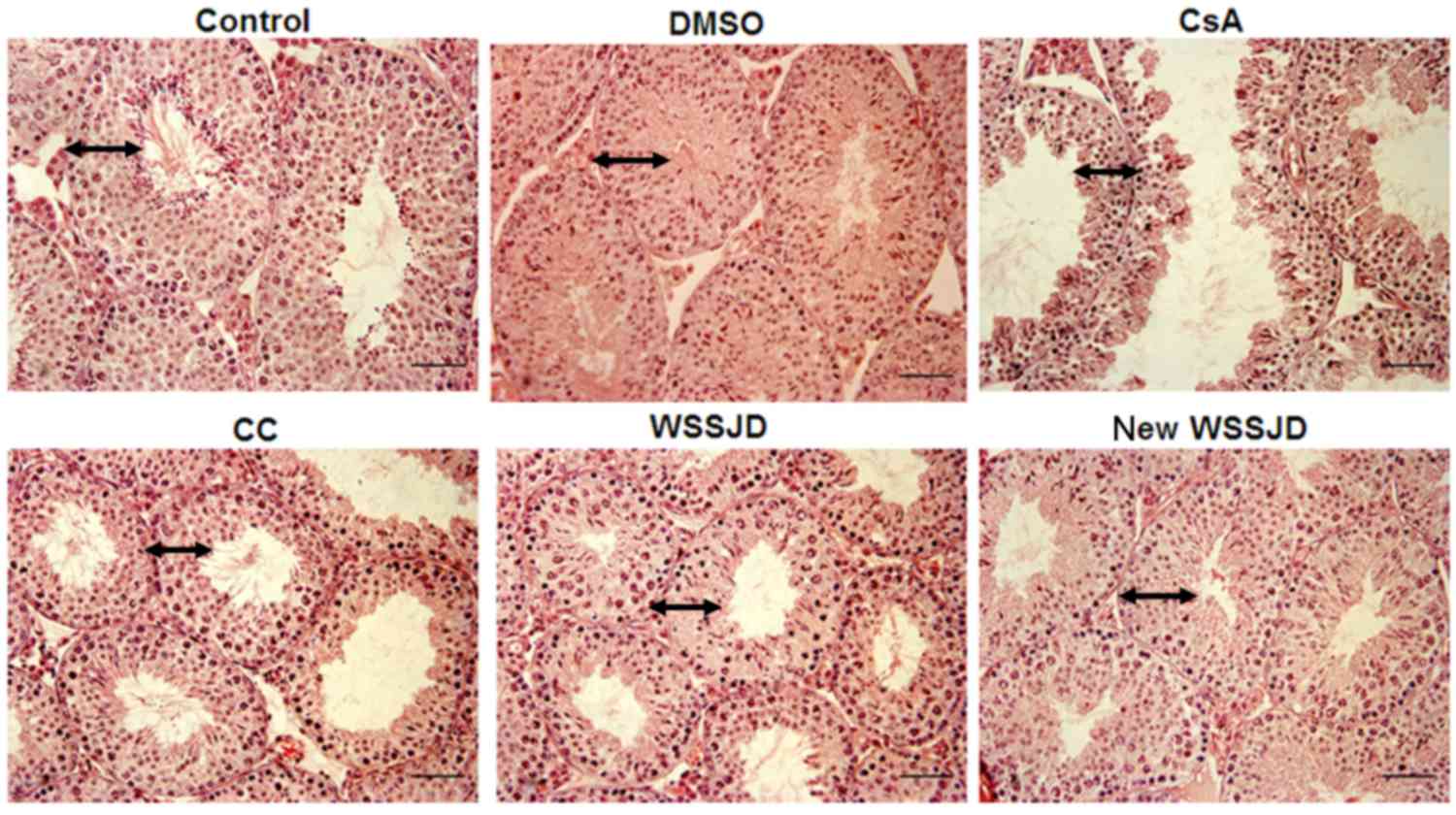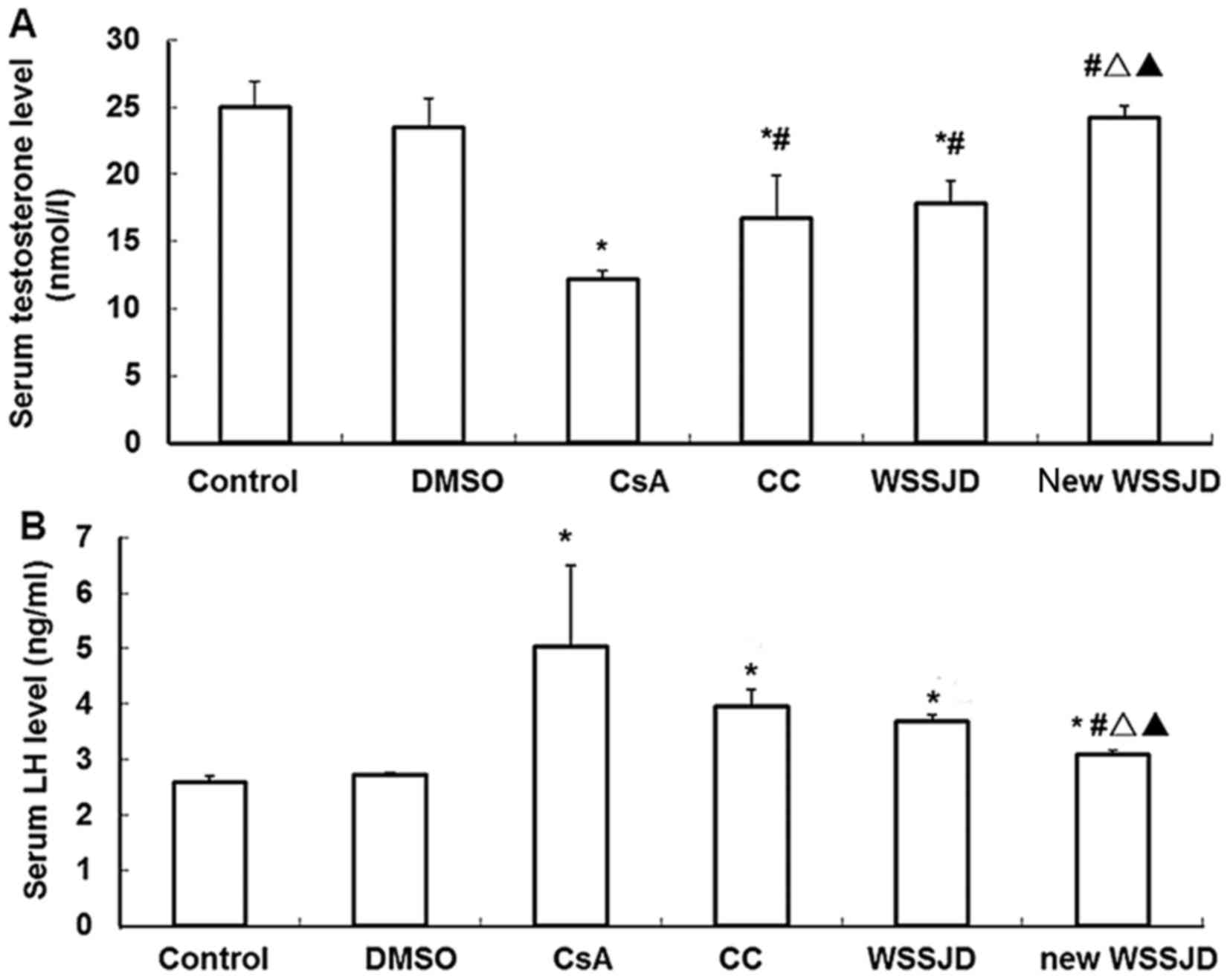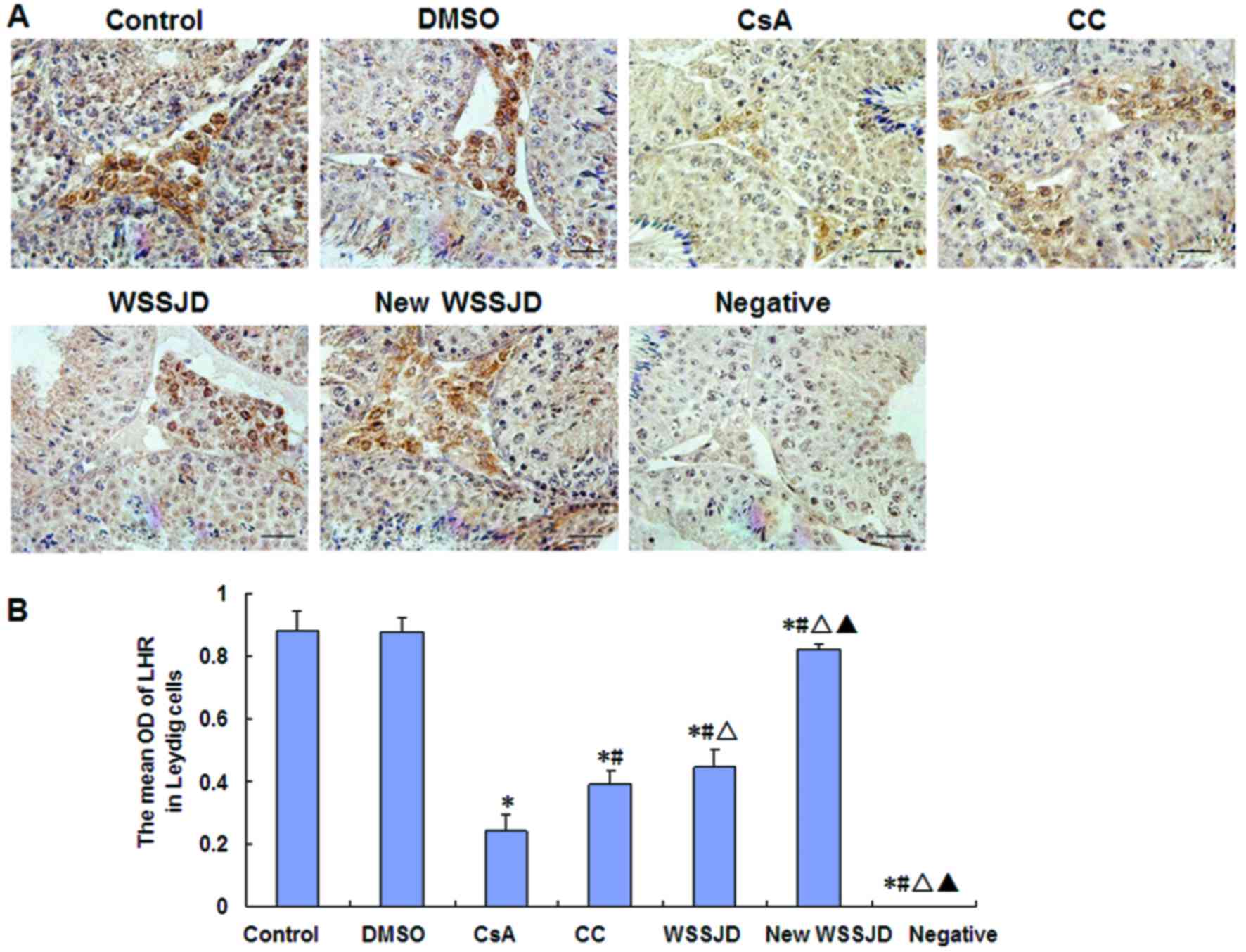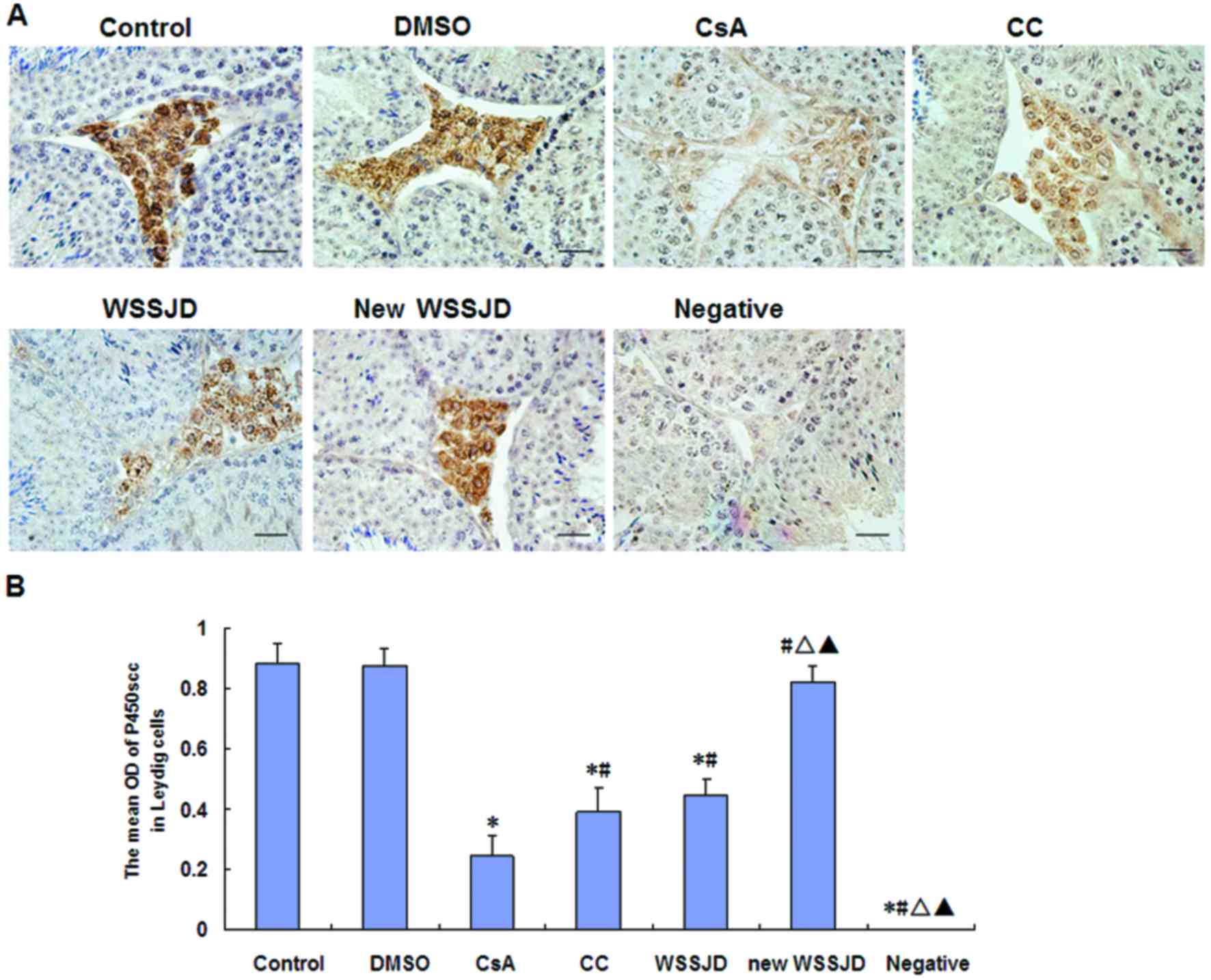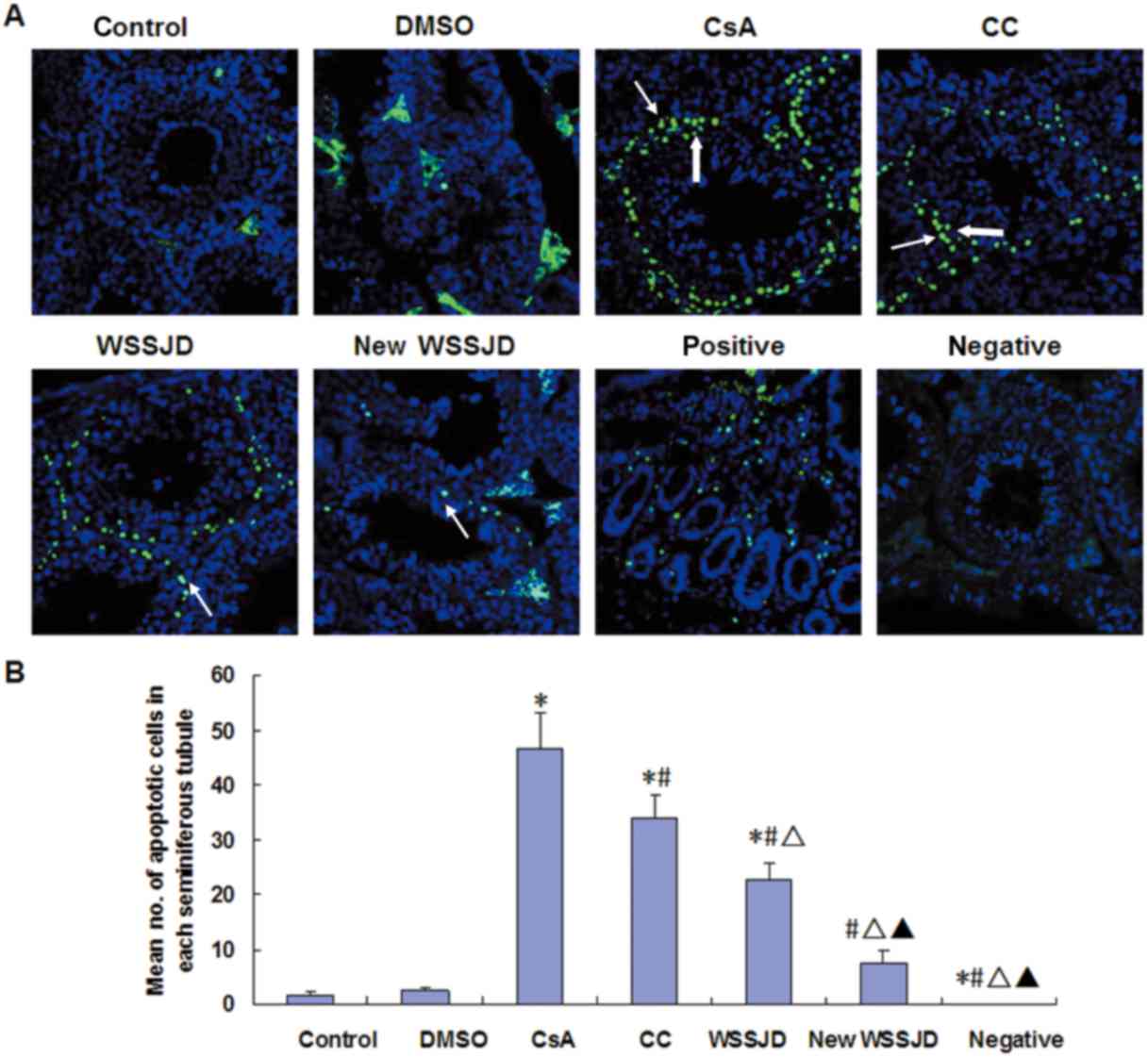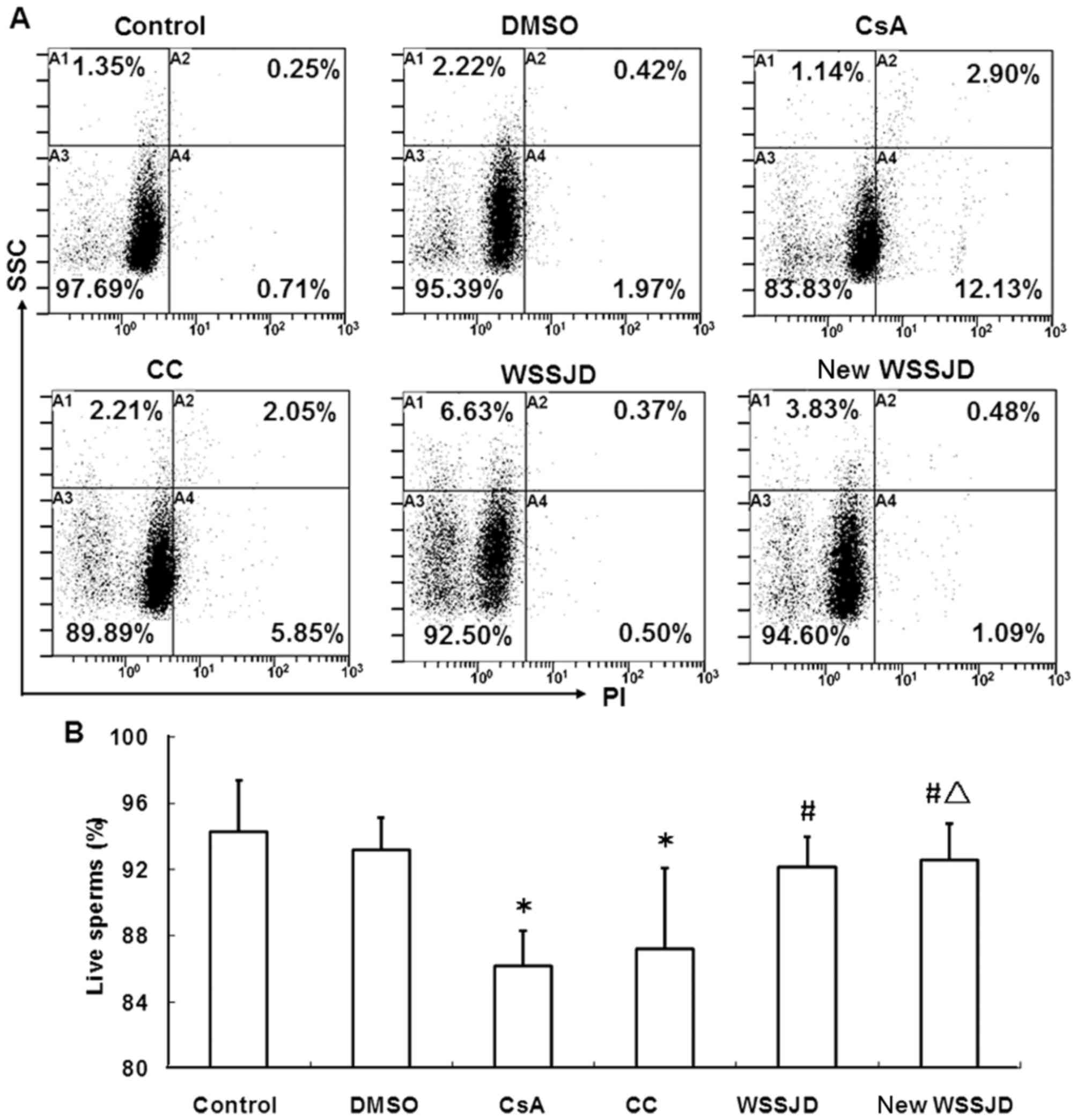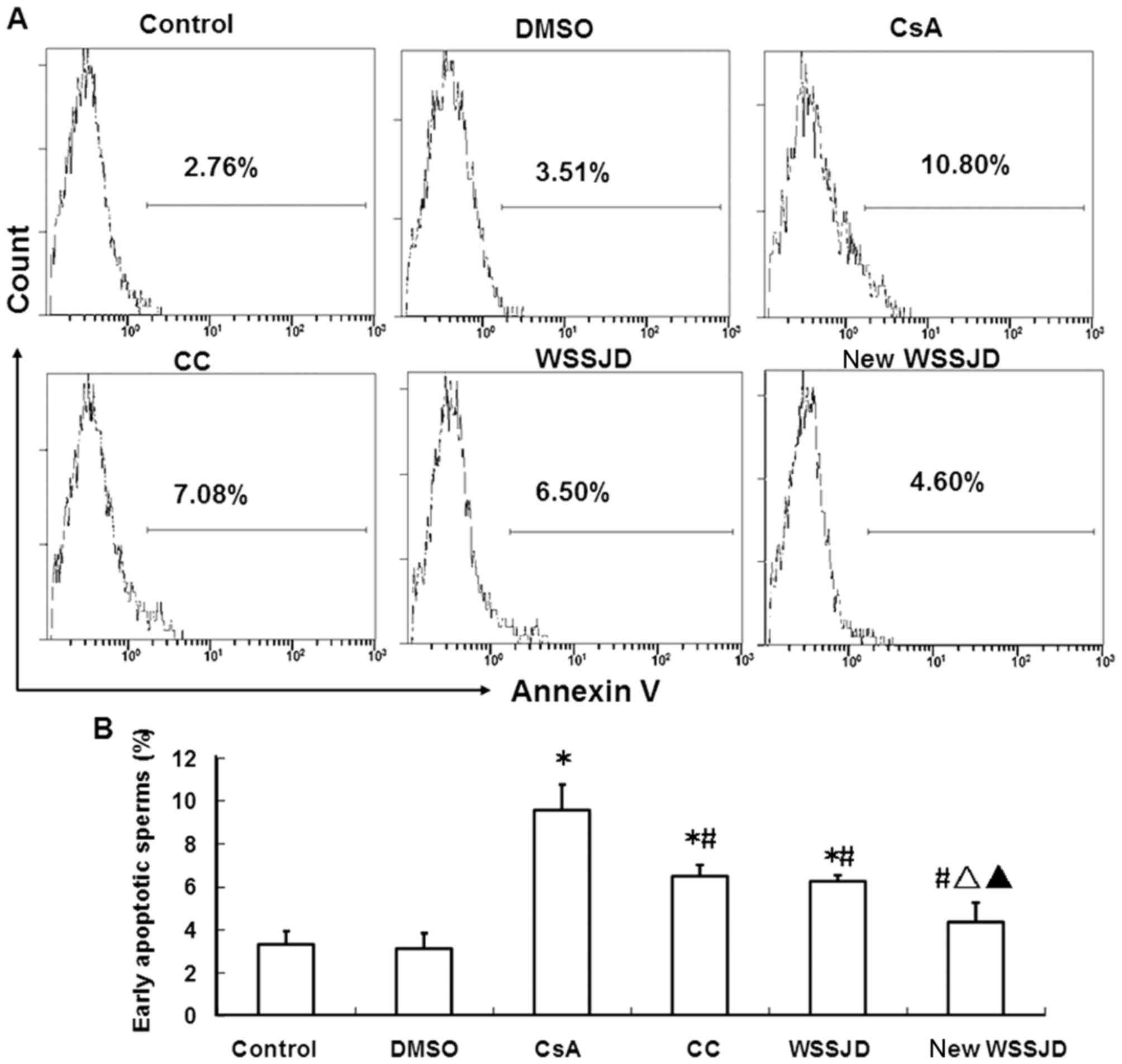Protective effects of new Wenshen Shengjing Decoction on cyclosporine‑induced impairment of testosterone synthesis and spermatogenic apoptosis
- Authors:
- Published online on: November 8, 2017 https://doi.org/10.3892/etm.2017.5473
- Pages: 813-821
-
Copyright: © Pan et al. This is an open access article distributed under the terms of Creative Commons Attribution License.
Abstract
Introduction
Cyclosporine A (CsA) is a commonly used immunosuppressive agent that specifically targets T cells and inhibits the secretion of interleukin-2, and dramatically increases the success rate of liver, kidney and cornea transplantations, as well as the survival rate of recipients (1–3). However, immunosuppression induced by long-term CsA use significantly increases the risk of cardiovascular diseases, infection and malignant tumors (4). Eid et al (5) reported that the concentration and motility of sperm were negatively correlated with the concentration of serum CsA in male kidney transplant recipients, suggesting that CsA may induce dysfunction of the reproductive system in male recipients. Furthermore, it has been documented that CsA may be responsible for impaired spermatogenesis and damage to the male reproductive system (6).
Previous studies have demonstrated that CsA decreased the levels of serum testosterone by influencing testosterone biosynthesis and secretion in the testes. He et al (7) observed that rats treated with 40 mg/kg/day CsA exhibited significantly higher levels of luteinizing hormone (LH) and significantly lower levels of testosterone in the serum, leading to impaired testicular development. Ali et al (8) reported that treatment with CsA decreased the expression of LH receptor (LHR) on the membrane of Leydig cells, which subsequently decreased LH-mediated testosterone synthesis and secretion from Leydig cells. Another study by Seethalakshmi et al (9) reported that CsA decreased testosterone levels by inhibiting the activity of 17 alpha-hydroxylase uncompetitively and 17β-hydroxydteroid dehydrogenase activity competitively during testosterone biosynthesis, and the primary site for CsA inhibition was interrupted cyclic adenosine monophosphate stimulation. Furthermore, this report indicated that decreased testosterone secretion induced by CsA in Leydig cells directly influenced development of the male reproductive system and maintenance of reproductive ability. Seethalakshmi et al (10) injected exogenous testosterone into CsA-treated rats to increase endogenous testosterone levels. It was observed that the elevated doses of exogenous testosterone significantly restored reproductive organ weight, serum levels of follicle-stimulating hormone (FSH) and increased the germ cell count, thus indicating that CsA-induced impairment of spermatogenesis may be partially prevented by the exogenous administration of testosterone (10). However, exogenous testosterone was found to be insufficient in repairing damaged testicular tissue, as testosterone secretion and spermatogenesis were still influenced by CsA, and high rates of apoptosis were observed in sperm and spermatogenic cells (10).
Wenshen Shengjing Decoction (WSSJD) consists of 15 herbal medicines, primarily including Cornu Cervi Nippon Parvum, Panax ginseng, Cynomorium songaricum, Cistanche deserticola, Radix Astragali, Epimedium brevicornum and Angelica sinensis (11). WSSJD has been demonstrated to alleviate cyclophosphamide-induced spermatogenic apoptosis (11). To further improve the therapeutic effect of WSSJD, the present study developed a new WSSJD based on the mechanism of CsA-induced testicular tissue damage by adjusting the dosage of the WSSJD components. Modern pharmacological studies have demonstrated that antler velvet in WSSJD may function as a sex hormone (12); Radix Astragali may improve the proliferation and nutrient supply of testicular sertoli cells (13); and Panax ginseng may decrease testicular hyperoxide levels and inhibit spermatogenic apoptosis (14). The above-mentioned medicines may also increase kidney function and boost the development of spermatogenic cells (12–14). Clomifene citrate (CC) has been demonstrated to exert therapeutics effect on male infertility in previous clinical studies (15,16). Furthermore, CC has been associated with improved testosterone and semen parameters, and the protective mechanisms of CC may be similar to those of WSSJD (15,16). In addition, in a study by Wang et al (17), CC was used as a treatment control to investigate the effect of the Chinese medicine Shengjing on spermatogenesis disturbances in mice. Based on this, CC was used as a positive control in the present study.
In the present study, the mechanism underlying the protective effect of new WSSJD in testicular tissues was investigated to determine the therapeutic efficacy of the modified medicine. Elucidating the protective mechanism may provide a basis for the use of new WSSJD in ameliorating CsA-induced spermatogenic damage.
Materials and methods
Animals
A total of 90 male Kunming mice (8-weeks-old; 35–40 g) were provided by the Changchun Institute of Biological Products Co., Ltd. (Changchun, China). The present study was conducted with approval from the Ethics Committee of Jilin Medical University (Changchun, China). Mice were housed at 21±3°C and 55–65% relative humidity under a 12 h dark-light cycle. Mice were given free access to a standard laboratory mouse diet and sterile water.
Preparation of WSSJD
The 15 Chinese medicine components of WSSJD, including Cornu Cervi Nippon Parvum, Panax ginseng, Cynomorium songaricum, Cistanche deserticola, Radix Astragali, Epimedium brevicornum and Angelica sinensis (11), were purchased from Tongrentang (Beijing, China). These materials were decocted according to the traditional method of Chinese medicinal decoction (18). In brief, the ingredients were weighed according to the recipe, and a total of 250 ml distilled water was added to submerge the herbs. Herbs were soaked for 30 min and subsequently heated. The herbs were first boiled for 10 min and then the heat was reduced to a simmer for 20 min. Following 30 min of heating, the liquid decoction was separated from the herbs, which were further decocted with 200 ml distilled water at 80°C for another 30 min. This process was repeated and the final volume of decoction liquid was filtered through 4–5 layers of gauze. Liquid was also squeezed from the herbs into the filtered decoction. The decoction was subsequently heated at 80°C in a water bath for 6–7 h until the concentration reached 2 g crude drug/ml, and the decoction was stored at 4°C prior to use. new WSSJD was prepared based on the formulation of WSSJD with minor adjustments to the dosages of Panax ginseng, Cynomorium songaricum, Radix Astragali and Epimedium brevicornum. The decocting method was the same as that of WSSJD. new WSSJD comprised of the following: Panax ginseng, 6 g; Cynomorium songaricum, 9 g; Radix Astragali, 12 g; Epimedium brevicornum, 6 g; Cornu Cervi Nippon Parvum, 1 g; Cistanche deserticola, 9 g; Angelica sinensis, 6 g; Flatstem Milkvetch Seed, 9 g; Rhizoma Dioscoreae, 15 g; Largehead Atractylodes Rhizome, 6 g; Ligusticum wallichii, 3 g; Radix Paeoniae Alba, 6 g; Cinnamomum cassia, 1 g; Costustoot, 1.5 g and Fructus Foeniculi, 3 g.
The concentrations of crude drug extracts were determined as follows: Weight of the crude material/final volume. This calculation method is widely used in the study of traditional Chinese medicine (19–21).
Drug administration
Mice were randomly divided into 6 groups (15 mice per group) and were administrated with medicine intragastrically. The groups were as follows: Control (normal saline); dimethylsulfoxide (DMSO); CsA; CC; WSSJD; and new WSSJD. Mice in the CsA, CC, WSSJD and new WSSJD groups were intraperitoneally (i.p.) injected with 15 mg/kg/day CsA (Shanxi Powerdone Pharmaceutics Co., Ltd., Datong, China) for 30 days, as described previously (8). Mice in the control and DMSO groups underwent a daily i.p. injection with an equal volume of normal saline or DMSO solvent, respectively, throughout the 30-day experimental period. The concentration of DMSO diluted in normal saline was 3.25% (v/v). The CC group was administered with 21.6 mg/kg/day CC (GKH Pharmaceutical, Ltd., Guangzhou, China) as described previously (13), which was also diluted in 3.25% (v/v) DMSO (pH=7.2). Mice in the WSSJD and new WSSJD groups were administered with 12 g crude drug/kg/day of WSSJD and new WSSJD, respectively.
Mouse euthanasia
At the end of the experimental period (at day 31), mice were placed in sealed cages, which were subsequently infused with 10–30% CO2. When mice ceased to move for 5 min, it was confirmed that mice had succumbed to CO2 exposure.
Hematoxylin and eosin (H&E) staining
Mice testes were harvested and immediately fixed in 4% paraformaldehyde (pH=7.2) at room temperature for 24 h, followed by ethanol dehydration, xylene treatment to remove the ethanol, wax embedding and sectioning. Histological sections (5 µm) were obtained using a rotary microtome. These were affixed to glass slides for H&E staining. Testicular sections were observed using highlight histopathological microscopy to evaluate the development of seminiferous tubules and obtain histometric data. The development of seminiferous tubules was assessed using the Johnsen scoring system (22).
ELISA
On day 30 of treatment, the mice were anesthetized with 10% chloral hydrate (Shanghai Guoyao Chemical Reagent Co., Ltd) at 0.004 ml/g of body weight i.p. prior to euthanasia with CO2. Trunk blood was harvested and the serum was separated and stored at −20°C. Briefly, blood was collected into 1.5-ml tubes and stored at 4°C overnight. The tube was then centrifuged at 1,300 × g at 4°C for 6 min and the serum was collected. ELISA kits (Shanghai Elisa Biotech Co., Ltd., Shanghai, China) were used to determine the serum contents of testosterone (cat. no. EIA-2380) and LH (cat. no. EIA-2385) according to the manufacturer's protocol. The optical density (OD) was determined using a Model 680 microplate reader (Bio-Rad Laboratories, Inc., Hercules, CA, USA), and the levels of testosterone and LH were determined based on the standard curve.
Immunohistochemistry
Testicular tissues were fixed in 4% formaldehyde at room temperature for 24 h and embedded in paraffin. Paraffin sections were cut into 5 µm sections and were subsequently dewaxed. Antigen retrieval was achieved by incubating sections in 0.01 M citrate buffer (pH=6.0) at 95–98°C for 5 min. The sections were subsequently blocked with 5% bovine serum albumin (Sigma-Aldrich; Merck KGaA, Darmstadt, Germany; A3675) at room temperature for 1 h. Following blocking, sections were incubated with rabbit polyclonal antibodies against LHR (cat. no. L6792; Sigma-Aldrich; Merck KGaA; 1:200) or P450 side chain cleavage (P450scc; cat. no. ab75497; Abcam, Cambridge, UK; 1:200) at 4°C overnight in the dark. The streptavidin-biotin complex (SABC) method was used to detect the expression of LHR and P450scc using an SABC kit (SA2010; Boster Biological Technology, Pleasanton, CA, USA), according to the manufacturer's protocol. For the tissues isolated from negative control mice, the primary antibody was replaced with PBS. Leydig cells with yellow or brown staining on the membrane or plasma were considered to be LHR-positive cells. Five slides were obtained from each sample and five fields in the Leydig tissue areas were selected at random and assessed under a fluorescence microscope (magnification, ×400). The mean OD of positive cells in the Leydig tissue areas was obtained using Image Pro Plus 6.0 software (Media Cybernetics, Inc., Rockville, MD, USA). The expressions of LHR and P450scc were proportional to the OD values, with higher OD values representing higher protein expressions.
Terminal dexynucleotidyl transferase (TdT)-mediated dUTP nick-end labeling (TUNEL) assay
Mice testes were dissected, embedded in wax and sectioned. The sections (5-µm thick) were then stained using the TUNEL assay kit (MK1024; Boster Biological Technology), according to the manufacturer's protocol. In brief, testicular tissues form control (normal saline), DMSO, CsA, CC, WSSJD and new WSSJD groups were stained using a 1:100 dilution of biotin labeled digoxin antibody for 30 min at 37°C. Stained rat interstitial epithelial tissue (provided in the kit) was used as a positive control, and samples incubated with PBS instead of biotin labeled digoxin antibody were used as a negative control. The frequency of TUNEL-positive cells exhibiting green nuclear staining was evaluated using a laser scanning confocal microscope. A total of 10 random fields were assessed under high-magnification (×400) and positive cells were counted. The mean number of positive cells per field was calculated.
Propidium iodide (PI) or Annexin V-fluorescein isothiocyanate (FITC) staining and flow cytometry analysis
The cauda epididymidis was harvested following sacrifice and the epidermis was cut with a blade to release the sperm from the epididymis into 2 ml PBS at 37°C to obtain epididymis suspensions. The suspensions were subsequently incubated at 37°C for 10 min to allow sperm to swim out. Aggregations of sperm were discarded and the remaining sperm samples were isolated and resuspended in PBS to give a concentration of 106 cells/ml. Sperm apoptosis was analyzed using a Annexin V-FITC Apoptosis Detection kit (Nanjing KeyGen Biotech Co., Ltd., Nanjing, China), according to the manufacturer's protocol. In brief, 1 ml of sperm suspension was stained with 10 µl PI or with 500 µl binding buffer and 5 µl Annexin V-FITC in the dark for 10 min at room temperature. Cells were immediately analyzed by Epies XL flow cytometry (Beckman Coulter, Inc.) and using a TetraONE™ System (6915050; Beckman Coulter, Inc.). Cells in the early stages of apoptosis were identified by Annexin V-positive staining and necrotic cells were identified by PI-positive staining.
Statistical analysis
Data analysis was performed using SPSS 13.0 software (SPSS, Inc., Chicago, IL, USA) and expressed as the mean + or ± standard deviation as indicated. Differences between groups were evaluated for significance using one-way analysis of variance followed by a Tukey's post hoc test. P<0.05 was considered to indicate a statistically significant difference.
Results
Effects of new WSSJD on the development of testicular seminiferous tubules
To investigate the potential protective effect of new WSSJD on the development of mouse testicular seminiferous tubules, the morphology of H&E-stained mouse testes were compared under light microscopy. The seminiferous tubules of mice from the CsA and CC groups exhibited shrinkage of the tubule fringe, decreased tubule diameters and reduced layers of testicular seminiferous epithelium compared with the control. In addition, spermatogenic cells exhibited a disordered arrangement, the number of spermatogenic cells was reduced and few mature sperm were visible in the lumen (Fig. 1). In mice from the DMSO, WSSJD and new WSSJD groups, more layers of testicular seminiferous epithelia were visible and the seminiferous tubule fringe was integrated without shrinkage or collapse (Fig. 1). The Johnsen scores did not differ significantly between the DMSO group and control groups, or between the CC and DMSO groups. However, the Johnsen score was significantly decreased in the CsA group and WSSJD group compared with the control group, and the scores of the WSSJD and new WSSJD groups were significantly increased compared with the CC or CsA group (P<0.05; Table I). These results indicated that new WSSJD and WSSJD promoted the development of seminiferous epithelium following CsA treatment.
Effects of new WSSJD on serum testosterone and LH
The levels of testosterone and LH in the serum were subsequently measured. Serum levels of testosterone and LH were unaffected following DMSO administration. By contrast, serum testosterone was significantly downregulated and LH was significantly upregulated in CsA-treated mice, relative to controls (P<0.05; Fig. 2), and new WSSJD administration significantly restored testosterone to near control levels (P<0.05; Fig. 2). For serum LH, the protective effects of WSSJD was similar to that of CC; however, new WSSJD decreased serum testosterone to a significantly lower level than that observed with CC and WSSJD (P<0.05; Fig. 2), suggesting a superior protective effect of new WSSJD over CC or WSSJD.
Effects of new WSSJD on the expressions of LHR and P450scc
The expressions of P450scc and LHR were assessed in testicular Leydig cells by immunohistochemistry (Figs. 3 and 4). In the control group, LHR was expressed on the outer membranes of Leydig cells between the seminiferous tubules (Fig. 3A), and P450cc was expressed in the cytoplasm of testicular Leydig cells (Fig. 4A). DMSO treatment had no significant effect on the expressions of LHR and P450scc. By contrast, CsA treatment significantly decreased the expressions of LHR and P450scc compared with control mice (P<0.05; Figs. 3B and 4B). In turn, the expressions of LHR and P450scc were significantly increased by treatment with CC, WSSJD or new WSSJD compared with the CsA group (P<0.05; Figs. 3B and 4B). In addition, levels of LHR and P450scc in testicular Leydig cells were significantly higher in WSSJD and new WSSJD mice compared with CC mice (P<0.05; Figs. 3B and 4B), and new WSSJD induced a significantly greater upregulation than WSSJD (P<0.05; Figs. 3B and 4B).
Effect of new WSSJD on spermatogenic cell apoptosis
The apoptosis of spermatogenic cells in the mouse testes was analyzed by a TUNEL assay. The nuclei of apoptotic cells were principally observed in the spermatogonia and primary spermatocytes (Fig. 5A). Spermatogonia are larger than spermatocytes and are located closer to the basement membrane (23). DMSO treatment had no significant effect on the number of apoptotic spermatogenic cells in the testes. By contrast, treatment with CsA significantly increased the number of apoptotic spermatogenic cells compared with the control and DMSO groups (P<0.05; Fig. 5B). In turn, administration of CC, WSSJD or new WSSJD significantly reduced CsA-induced apoptosis (P<0.05; Fig. 5B). Furthermore, the number of apoptotic testicular spermatogenic cells in the WSSJD and new WSSJD groups was significantly reduced compared with the CC group (P<0.05), and new WSSJD was significantly more effective than WSSJD (P<0.05; Fig. 5B).
Effects of new WSSJD on the survival and early apoptosis of sperm
To verify the protective effects of new WSSJD against CsA-induced sperm apoptosis, the survival and early apoptosis of sperm in the epididymis were determined. Epididymal sperm were stained with PI or Annexin V and analyzed by flow cytometry (Figs. 6 and 7). In accordance with the aforementioned results, CsA treatment significantly reduced the percentage of live sperm and significantly increased the percentage of early apoptotic sperm (P<0.05; Figs. 6B and 7B), while DMSO treatment had no effect. WSSJD and new WSSJD significantly increased the percentage of live sperm (P<0.05; Fig. 6B) and reduced the percentage of early apoptosis sperm (P<0.05; Fig. 7B) compared with CsA treatment. The percentages of live and early apoptotic sperm in WSSJD and CC mice did not differ significantly, while new WSSJD induced a significantly greater increase in live sperm percentage compared with the CC group (P<0.05; Fig. 6B) and significantly decreased the percentage of early apoptotic sperm compared with the CC and WSSJD groups (P<0.05; Fig. 7B).
Discussion
It has previously been documented that long-term use of CsA as an immunosuppressive agent affects reproductive capacity (6). Xu (24) reported that the morphology and vitality of sperm in patients treated with CsA were significantly lower than that in an untreated group, as observed in the semen samples of 26 renal transplant recipients treated with various doses of CsA and 12 healthy volunteers. It was also observed that head deformity rates of sperm were significantly higher in CsA-treated recipients (24). These results suggested that CsA had a dose-dependent effect on semen parameters. Therefore, studies are warranted to identify novel pharmacological agents capable of alleviating CsA-induced testicular damage and improving male reproductive ability following organ transplantation.
The specific microenvironment of the testis promotes spermatogenesis, and thus impairment of testicular structure and function may lead to spermatogenic arrest (25). Monteiro et al (26) treated Wistar rats with CsA at a dose of 15 mg/kg per day for 56 days, and observed an increased volumetric proportion of connective tissue and decreased volumetric proportion of Leydig cells in CsA-treated rats. It was also observed that CsA caused seminiferous epithelium degeneration, resulting in Sertoli cell vacuolization, abnormal round and elongated spermatids and the accumulation of residual cytoplasm at the epithelium border adjacent to the lumen (26). In the present study, Kunming mice were treated with 15 mg/kg CsA daily for 30 days, which lead to shrinkage and decreased diameters of the seminiferous tubules, reduction of the seminiferous epithelium layers, disordered arrangement of the seminiferous cells, a decrease in mature sperm in the lumen and a significantly decreased Johnsen score. In addition, treatment with CsA treatment severely damaged the testicular structure. The present study also evaluated the protective effects of new WSSJD, as a novel Chinese medicine, on the testes of CsA-treated mice. It was observed that the testicular seminiferous epithelia layers and arrangement of the seminiferous cells were restored following treatment with new WSSJD. In addition, mice in the new WSSJD group exhibited integrated seminiferous tubules without shrinkage or collapse, and had a significantly higher Johnsen score compared with CsA-treated mice. These results suggested that WSSJD significantly repaired CsA-induced testicular damage, indicating that this herbal medicine compound may be an effective treatment in the prevention of CsA-induced testicular damage. Whether or not this cell repair is dependent on the niche within the epithelium is also an important question, which should be investigated in future studies.
The hypothalamic-pituitary-testicular axis serves an important role in the regulation of genital activity (27). The development and functionality of the male genital organs are regulated by hormones from the hypothalamus and pituitary glands (28). Krueger et al (29) treated Sprague Dawley rats with 25 mg/kg/day CsA or 40 mg/kg/day CsA for 6 days and observed that serum levels of LH and FSH increased by 2–4 fold, while P450scc expression decreased to 30% of that in the control group. In addition, serum testosterone levels were significantly decreased in CsA-treated mice, resulting in impaired spermatogenesis (29). In the present study, it was demonstrated that CsA treatment significantly decreased the expression of LHR in Leydig cells. Although serum LH was increased, decreased expression of LHR may have impaired LH-mediated recovery of testosterone biosynthesis and decreased the expression of P450scc, as the rate-limiting enzyme of testosterone biosynthesis (30), thus affecting testosterone biosynthesis by Leydig cells. The novel ingredients in new WSSJD, such as pilose antler, exhibit effects similar to sex hormones (12), which may improve serum testosterone levels and decrease serum LH levels, thus increasing LHR and p450scc expression in Leydig cells. Notably, the present results indicated that new WSSJD stimulated testosterone biosynthesis and secretion in Leydig cells to promote spermatogenesis.
CsA-induced oxidative stress and testis damage induce the dysplasia of sperm and spermatogenic cells (31). It has been reported that long-term CsA treatment damages the antioxidant system in animal testicular tissues, leading to decreased levels of glutathione, glutathione peroxidase and hydrogen peroxide levels and increased levels of malonic dialdehyde in the testes (31). Therefore, excessive levels of reactive oxygen species in the testicular tissues cannot be eliminated, leading to the peroxidation of sperm membrane lipids, DNA damage and decreased sperm vitality. In the present study, it was observed that CsA treatment significantly increased DNA breakage and the apoptotic rate of spermatogenic cells in seminiferous tubules. The survival rate of sperm in the epididymis also decreased, while the percentage of early apoptotic sperm was increased, indicating that the spermatogenic activity of the testes was significantly damaged. Türk et al (32) documented that the protective effect of ellagic acid on CsA-induced testicular damage was associated with oxidative stress in male rats. The new WSSJD used in the present study contains various antioxidant components, including the herbal medicine Ginseng, which has previously been demonstrated to significantly decrease levels of hyperoxide in the testes (14).
In the present study, the effects of new WSSJD on CsA-induced impairment of testosterone synthesis and spermatogenic apoptosis were investigated, and it was observed that new WSSJD significantly decreased the apoptotic rates of spermatogenic cells and sperm, and thus repaired damage to the testicular seminiferous epithelium. The morphology of testicular seminiferous tubules and the apoptosis of spermatogenic cells and sperm were investigated using histochemistry and flow cytometry. Although cell cycle distribution and daily sperm production were not investigated, they will be the focus of future studies by our group.
In conclusion, compared with traditional WSSJD, new WSSJD significantly increased testosterone levels in the testes and decreased the apoptosis of spermatogenic cells and sperm, which effectively repaired CsA-induced testicular damage. These results indicate that new WSSJD may be a useful pharmacological agent in the treatment and prevention of CsA-induced testicular damage.
Acknowledgements
The present study was supported by the Key Research Project of the Scientific and Technological Development Program of Jilin Province (grant no. 20140204033YY), the College Science and Technology Program of Shandong Province (grant no. J13LL04) and the Undergraduate Training Programs for Innovation and Entrepreneurship of Jilin Province (grant no. 2014024).
References
|
Pedersen M and Seetharam A: Infections after orthotopic liver transplantation. J Clin Exp Hepatol. 4:347–360. 2014. View Article : Google Scholar : PubMed/NCBI | |
|
Vora GK and Ciolino JB: Corneal allograft reaction associated with nonocular inflammation. Digit J Ophthalmol. 20:29–31. 2014.PubMed/NCBI | |
|
De Pasquale C, Veroux M, Indelicato L, Sinagra N, Giaquinta A, Fornaro M, Veroux P and Pistorio ML: Psychopathological aspects of kidney transplantation: Efficacy of a multidisciplinary team. World J Transplant. 4:267–275. 2014. View Article : Google Scholar : PubMed/NCBI | |
|
El-Gowelli HM and El-Mas MM: Central modulation of cyclosporine-induced hypertension. Naunyn Schmiedebergs Arch Pharmacol. 388:351–361. 2015. View Article : Google Scholar : PubMed/NCBI | |
|
Eid MM, Abdel-Hamid IA, Sobh MA and el-Saied MA: Assessment of sperm motion characteristics in infertile renal transplant recipients using computerized analysis. Int J Androl. 19:338–344. 1996. View Article : Google Scholar : PubMed/NCBI | |
|
Zahra A, Gholamreza N, Farokhi F and Shalizar Jalali A: Attenuation of cyclosporine-induced sperm impairment and embryotoxicity by crataegus monogyna fruit aqueous extract. Cell J. 15:198–205. 2013.PubMed/NCBI | |
|
He Z, Qiu J, Li J, Zhao D, Chen G and Chen L: Long-term effects of conversion from cyclosporine to rapamycin on testicular function and morphology in a rat transplantation model. Transplant Proc. 45:pp. 763–769. 2013; View Article : Google Scholar : PubMed/NCBI | |
|
Ali RB, Klouz A, Boubaker S, Lakhal M and Belkahia C: An animal model of testicular toxicity by cyclosporine: Evaluation and protection. Fundam Clin Pharmacol. 23:241–246. 2009. View Article : Google Scholar : PubMed/NCBI | |
|
Seethalakshmi L, Flores C, Malhotra RK, Pallias JD, Tharakan D, Khauli RB and Menon M: The mechanism of cyclosporine's action in the inhibition of testosterone biosynthesis by rat Leydig cells in vitro. Transplantation. 53:190–195. 1992. View Article : Google Scholar : PubMed/NCBI | |
|
Seethalakshmi L, Flores C, Carboni AA and Menon M: Quantitative maintenance of spermatogenesis in cyclosporine-treated rats by exogenous administration of testosterone propionate. J Androl. 11:491–497. 1990.PubMed/NCBI | |
|
Pan XY, Wang XY, Wang XN, Sun ZX, Wang D, Wang X, Yang YY and Li ZX: Effects of ‘Wenshen Shengjing Decoction’ on cyclophosphamide induced spermatogenic cell apoptosis and histone H3K9 dimethylation. Shanghai Zhong Yi Yao Za Zhi. 48:82–86. 2014.(In Chinese). | |
|
Xu ZH, Li SF, Wang JY, Zhou R and Tian SJ: Extraction of sex hormone from antler velvet with supercritical CO2. Zhongguo Zhong Yao Za Zhi. 32:2000–2003. 2007.(In Chinese). PubMed/NCBI | |
|
Zhao LP, Xu Z, Zhang M, Sun HC and Tang F: Effects of Fructus Lycii and Radix astragali on the function of sertoli cells in rat testes. Zhonghua Nan Ke Xue. 13:82–86. 2007.(In Chinese). PubMed/NCBI | |
|
Xu L, Liu XH and Zhang L: Effects of total ginsenosides on the NO NOS and total antioxygen capacity in the testis of mouse. Acta Academiae Medicinae CPAPF. 5:507–508. 2006.(In Chinese). | |
|
Patel DP, Brant WO, Myers JB, Presson AP, Johnstone EB, Dorais JA, Aston KI, Carrell DT and Hotaling JM: The safety and efficacy of clomiphene citrate in hypoandrogenic and subfertile men. Int J Impot Res. 27:221–224. 2015. View Article : Google Scholar : PubMed/NCBI | |
|
ElSheikh MG, Hosny MB, Elshenoufy A, Elghamrawi H, Fayad A and Abdelrahman S: Combination of vitamin E and clomiphene citrate in treating patients with idiopathic oligoasthenozoospermia: A prospective, randomized trial. Andrology. 3:864–867. 2015. View Article : Google Scholar : PubMed/NCBI | |
|
Wang R, Xu L, Zhang WX, Wu YF, Shi JH and Zhang YX: Shengjing Granule: An Effective Chinese Medicine for Spermatogenic Disturbance in Mice. Zhonghua Nan Ke Xue. 14:1046–1049. 2008.(In Chinese). PubMed/NCBI | |
|
Fan BT: Chinese Medicine Pharmacy. Shanghai Science and Technology Press; 12. pp. 62–68. 1997, (In Chinese). | |
|
Zhang J, Li H, Lu L, Yan L, Yang X, Shi Z and Li D: The Yiqi and Yangyin Formula ameliorates injury to the hematopoietic system induced by total body irradiation. J Radiat Res. 58:1–7. 2017. View Article : Google Scholar : PubMed/NCBI | |
|
Minami M, Konishi T, Jiang Z, Arai T and Makino T: Effect of Shin'iseihaito on murine allergic reaction induced by nasal sensitization. J Tradit Complement Med. 6:252–256. 2015. View Article : Google Scholar : PubMed/NCBI | |
|
Rong R, Li RR, Hou YB, Li J, Ding JX, Zhang CB and Yang Y: Mahuang-xixin-fuzi decoction reduces the infection of influenza a virus in kidney-yang deficiency syndrome mice. J Ethnopharmacol. 192:217–224. 2016. View Article : Google Scholar : PubMed/NCBI | |
|
Johnsen SG: Testicular biopsy score count-a method for registration of spermatogenesis in human testes: Normal values and results in 335 hypogonadal males. Hormones. 1:2–25. 1970.PubMed/NCBI | |
|
Mays-Hoopes LL, Bolen J, Riggs AD and Singer-Sam J: Preparation of spermatogonia, spermatocytes, and round spermatids for analysis of gene expression using fluorescence-activated cell sorting. Biol Reprod. 53:1003–1011. 1995. View Article : Google Scholar : PubMed/NCBI | |
|
Xu LG: Influence of cyclosporin A on the semen parameters of the patients after renal transplantation. J Clin Urol. 20:603–605. 2005. | |
|
Pintus E, Ros-Santaella JL and Garde JJ: Beyond testis size: Links between spermatogenesis and sperm traits in a seasonal breeding mammal. PLoS One. 10:e01392402015. View Article : Google Scholar : PubMed/NCBI | |
|
Monteiro JC, Predes FS, Matta SL and Dolder H: Heteropterys aphrodisiaca infusion reduces the collateral effects of cyclosporine A on the testis. Anat Rec (Hoboken). 291:809–817. 2008. View Article : Google Scholar : PubMed/NCBI | |
|
Oseko F, Note S, Morikawa K, Endo J, Taniguchi A and Imura H: Influence of chronic hyperprolactinemia induced by sulpiride on the hypothalamo-pituitary-testicular axis in normal men. Fertil Steril. 44:106–111. 1985. View Article : Google Scholar : PubMed/NCBI | |
|
Wisniewski P, Romano RM, Kizys MM, Oliveira KC, Kasamatsu T, Giannocco G, Chiamolera MI, Dias-da-Silva MR and Romano MA: Adult exposure to bisphenol A (BPA) in Wistar rats reduces sperm quality with disruption of the hypothalamic-pituitary-testicular axis. Toxicology. 329:1–9. 2015. View Article : Google Scholar : PubMed/NCBI | |
|
Krueger BA, Trakshel GM, Sluss PM and Maines MD: Cyclosporin-mediated depression of luteinizing hormone receptors and heme biosynthesis in rat testes: A possible mechanism for decrease in serum testosterone. Endocrinology. 129:2647–2654. 1991. View Article : Google Scholar : PubMed/NCBI | |
|
Nolan CJ and Payne AH: Genotype at the P450scc locus determines differences in the amount of P450scc protein and maximal testosterone production in mouse Leydig cells. Mol Endocrinol. 4:1459–1464. 1990. View Article : Google Scholar : PubMed/NCBI | |
|
Türk G, Ateşşahin A, Sönmez M, Yüce A and Ceribaşi AO: Lycopene protects against cyclosporine A-induced testicular toxicity in rats. Theriogenology. 67:778–785. 2007. View Article : Google Scholar : PubMed/NCBI | |
|
Türk G, Sönmez M, Ceribaşi AO, Yüce A and Ateşşahin A: Attenuation of cyclosporine A-induced testicular and spermatozoal damages associated with oxidative stress by ellagic acid. Int Immunopharmacol. 10:177–182. 2010. View Article : Google Scholar : PubMed/NCBI |



